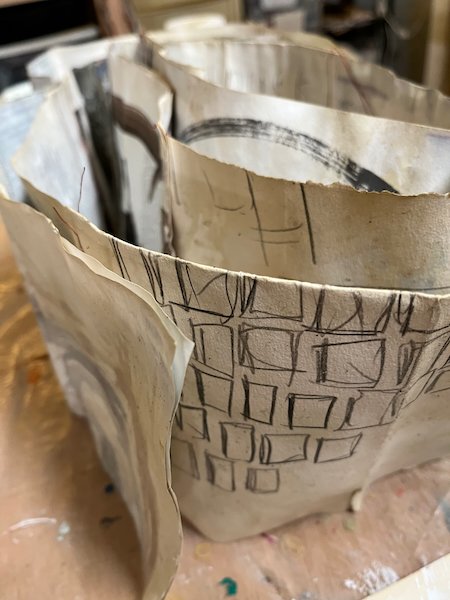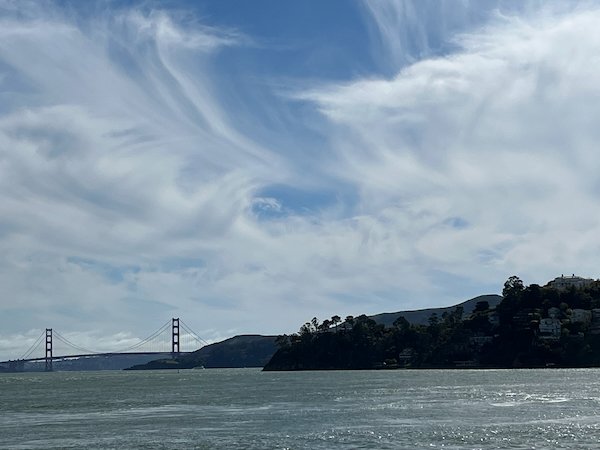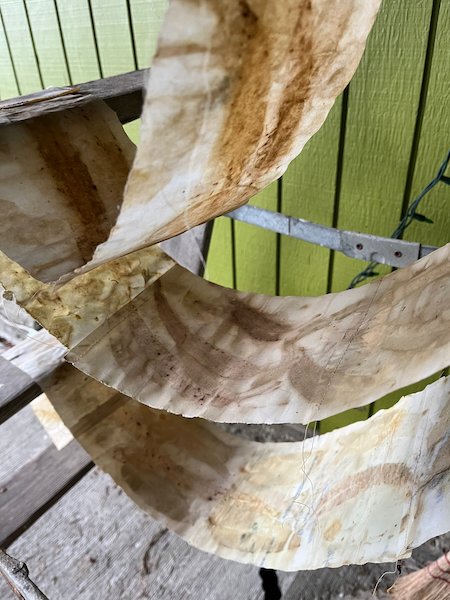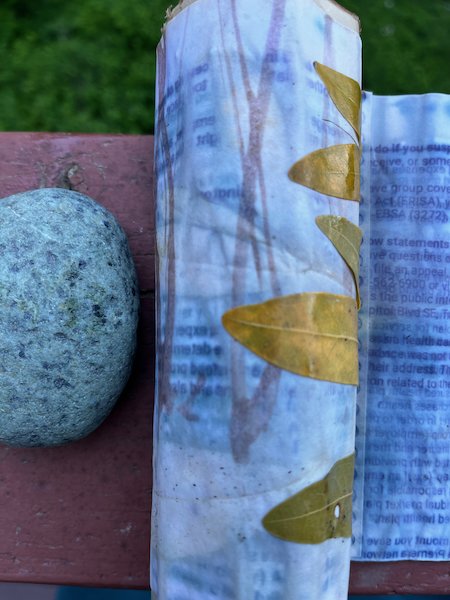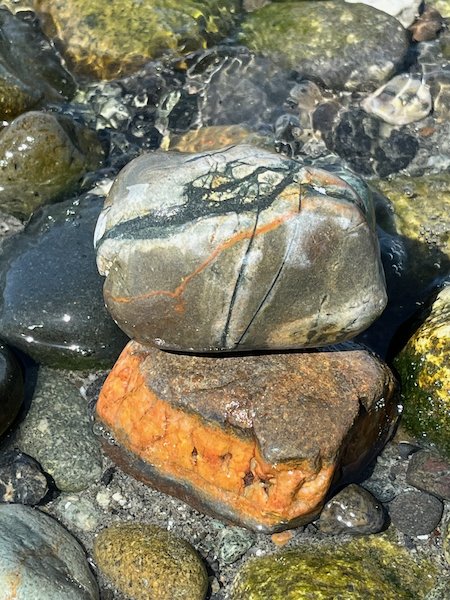At first, I was captured by the idea of reusing paper from old notebooks and elsewhere in my studio, recycle bin, ancient book pages, bags, receipts, collage stock, etc, to make long scrolls that fold into concertina/accordion books. The inspiration and guidance comes from India Flint’s beautiful online Salvage Sketchbooks workshop. Ever since I saw the foraging list, I’ve been digging up papers here and there, remembering bits I’ve been saving, (like the sweetly erratic first-grade writings of my partner’s students on the classic school paper,) and ravaging old notebooks (like the journal that became a nest in the last post.)
Painting with lichen on a stick and watercolor. Also shown is walnut ink (brown) and black sumi ink. India Flint makes use of all kinds of natural tools, which has encouraged me to try found feathers as quills - some of the scribbling at lower right is early feather use.
I got so caught up in the joining and decorating of papers, some of them have very little room left to write or paint in - but they make entertaining story books as they are, feeding my morning reflections and chatting with other drawings and paintings and sets of words.
The top is the Hamlet pages (see below), bottom left is the inside cover of the Hamlet book. Bottom right is my first handmade bound book, just a few signatures stitched up with no cover - also part of this current exploration.
It was exciting to have a couple of very old books ready to dissect and reconfigure: a 1912 edition of Shakespeare’s Hamlet that my grandfather and his brother both used in high school, and an equally old and brilliantly battered and ink stained Seat Work & Industrial Occupations, a book full of ideas for classroom creation which I scored from the free bin at the used bookstore in town. The old paper, especially in the Hamlet, is very delicate, so it’s just as well I painted all over these pages and saved other methods for newer papers. The fragility gives me a good excuse to use collage, and encourages a lack of attachment to any end result - although I’m taking lots and lots of pictures.
The pages were removed, and the covers are used to hold the accordion books, made from the removed pages and other papers. In the case of Hamlet, one accordion book is glued to the cover, but others are just packed in and tied up. The pages turn perpendicular to the spine of the book, as you can see in the photo above.
I love the view of the ends, with all the variety of pages showing their enticing edges.
Hamlet pages on top, with reinforcing collage in progress. Lower papers are being handstitched in preparation for dyeing. Unused pages from notebooks, bits of a book on insurance which I love painting over, and a printed image of Rilke’s handwriting from the Schweizerische Nationalbibliothek website of collected letters. Coffee filters are coming in handy as collage material (hello, Sarah!!)
Then came the simmering of books with leaves, which I had never tried before. The first one I did folded, and not much happened in terms of printing (not leaves, but cedar sprigs - I think they may also have been too dry.)
First cooked book drying. The process changed the color and texture in interesting ways, even though the printing was not great throughout.
First try at printing with Western red cedar (Thuja plicata). The distortions of the ink on this page, and the hint of plant print make me rub my hands with glee.
The next one was rolled with eucalyptus leaves throughout. I took advantage of a road trip to Northern California to gather Eucalyptus viminalis and California bay (Umbellularia californica), both of which smell wonderful while cooking. My studio is strewn with paper, in piles and small bits, and sewn together in lengths, and I’m definitely not tired of this yet. Thinking of putting poetry into some of these books. (And onto this website, actually. I may have to work up to it a bit more, but I’m pushing things around to make room.)
Some excellent clouds over the Golden Gate Bridge.
Unrolling of the eucalyptus book after cooking. (Eucalyptus viminalis from California was used)
Eucalyptus book drying, draped over a ladder.
A book in a box. This one was machine stitched
I think there’s something about how the paper transforms after getting wet, buckling and revealing its own fluidity, that makes the book feel more imbued with possibility. It’s on the edge of transformation, could so easily return to pulp, and this very tenuousness invites the writing of secrets and spells, codes and invented scripts, messages to offer the forest or the sea.
Another expressive low tide.
Today I unrolled the one with California Bay leaves, and it has some very subtle and exciting shapes and movements in it. This reminds me of doing stitch-resist dyeing, seeing the patterns and influence of water as it interacts with materials and their color properties. So unpredictably lovely!
Unrolling the Bay leaves……
Image is extra blue because it’s morning, shady light, and still wet.
The blue-green here is seeping from the ink of the printed page, which is actually only the one left of the stitching. The text printed onto the next page, along with the leaves.
Suffice to say, I now look at all papers differently, and have the capacity to make endless sketchbooks, notebooks, poetry books, treasure books, magic tomes, that I won’t feel precious about using up (although some of them feel significant to me already, as receptacles of transformative practice.) The stitching, by the way, is a great use for weaving thrums, which I’ve always vacillated about keeping. So many elements are integrated here - and the stitching and interleaving of accordion books gives material form to the kind of looping and circling and joining I’ve been doing in my journals already. There’s this big, multilayered book of life that I keep delving into, surfacing somewhere and lashing thoughts and experiences together, usually in a flurry of flipping pages. Now I’m seeing them seep into one another more like the colors of print ink or fallen leaves.
Can’t let you go without today’s rocks. I mean… really! These two left me breathless.







